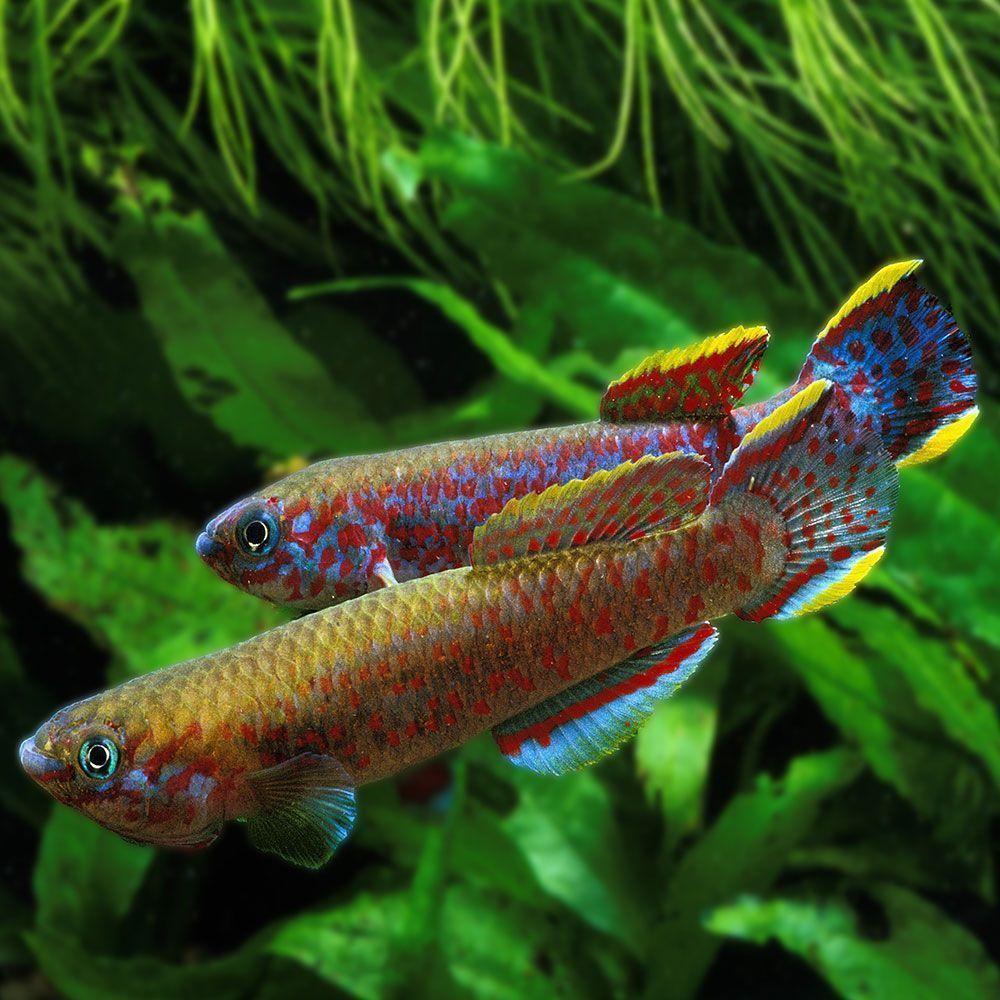If you are looking for a colorful fish for your freshwater tank that is fairly easy to care for, you must know more about killifish species.
These fish are extremely adaptable to a wide range of water conditions. With their unique color, fins, and personalities, they’re bound to mesmerize you. If you’re into breeding fish, these will definitely leave you amazed.
So, if you feel intrigued, let’s know more about this fascinating species.
What are Killifish?
Killifish are a diverse group of approximately 1,270 species of small fish belonging to various families, including Aplocheilidae, Cyprinodontidae, Fundulidae, Profundulidae, and Valenciidae. The largest family within this group is Rivulidae, consisting of over 320 species.
These fish exhibit a wide range of appearances, habitats, and characteristics due to their vast diversity. But they are mainly found in brackish waters.
Killifish got their name from the Dutch word ‘killy,’ meaning a ditch or canal. They love being in shallow spots like water holes and streams, so they tend to stay small in size, perfectly suited to their habitat.
Many species are relatively small, typically ranging from 2.5-5 cm (1-2 in) in size, with some of the largest species reaching around 15 cm (6 in).
One interesting adaptation of killifish is their ability to lay eggs (oviparous) in ephemeral waters. This allows the eggs to survive periods of partial dehydration. Some species can even survive out of the water for several weeks.
Some of them are schooling and shoaling species.
Most males are territorial in the wild, but they can stand up to 3 males in the aquarium. Further, they are popular to be top dwellers and jumpers. These fish are loved for their stunning appearances and their ability to get along well with different types as well.
Now, if you want to get some of these species, here are our hand-picked favorites!
1. Clown Killifish (Epiplatys annulatus)
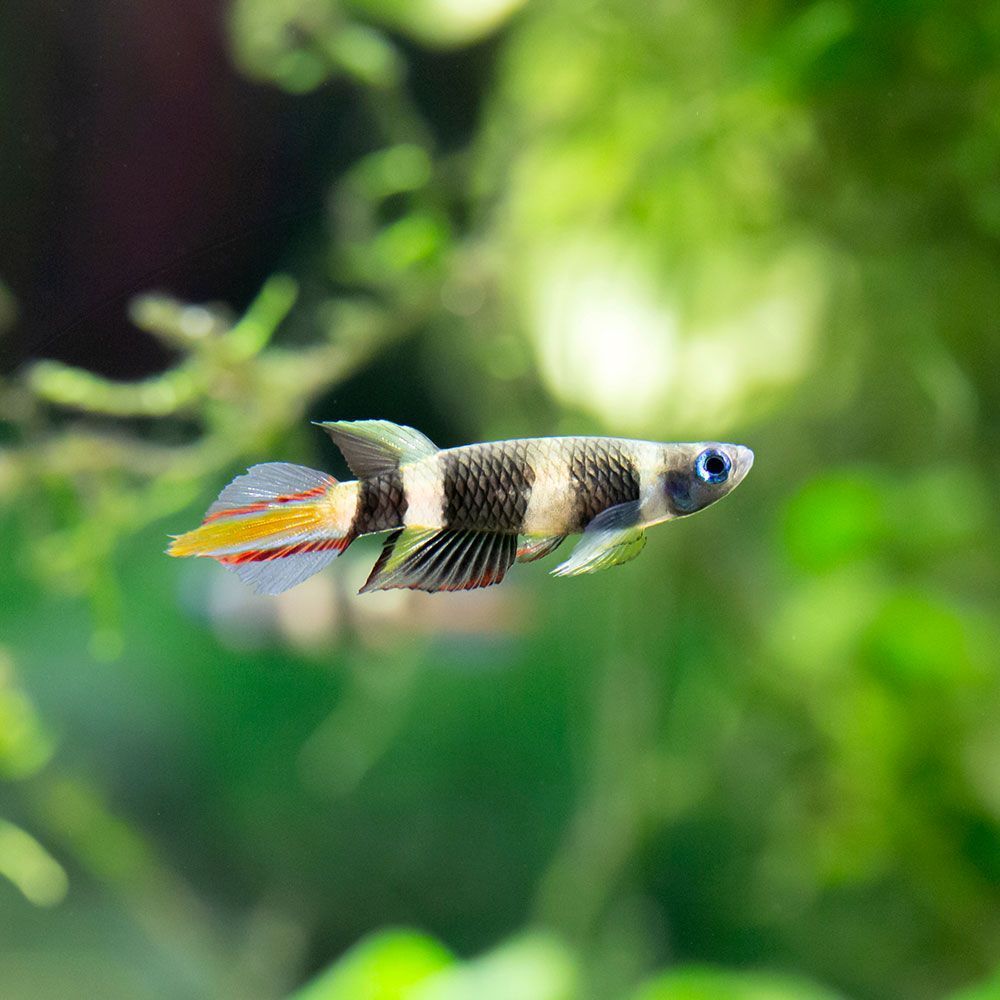
- Other Common Names: Rocket panchax, clown killie, banded panchax, rocket killie
- Average Size: Up to 3 cm (1.2 in) female; Up to 3.5 4 cm (1.4-1.6 in) male
- Average Lifespan: Up to 3-5 years
- Tank Level: Middle and top dwellers
- Temperament: Friendly, peaceful, predator
- Diet: Carnivorous (prefers live food)
- Tank Mates: Own school, other similar-sized, peaceful fish
- Minimum Tank Size:10 gallons for 2/3 pairs
The clown killifish resembles small rockets with torpedo-shaped bodies. Its body is cream-colored with upturned mouths, rounded heads, and dorsal fins toward the tail. Its tail fins are spade-shaped with long rays.
Color patterns vary according to the fish’s origin. The young clown killifish is less colorful but becomes more vibrant with age.
Males have vibrant black and yellow body stripes, blue and red tail stripes, and variable dorsal fin colors. Females are smaller and less colorful, with clear dorsal fins and shorter rays on the caudal fin.
Clown Killifish earned their name due to their vibrant colors, which resemble clown makeup.
2. Golden Wonder Killifish (Aplocheilus lineatus)
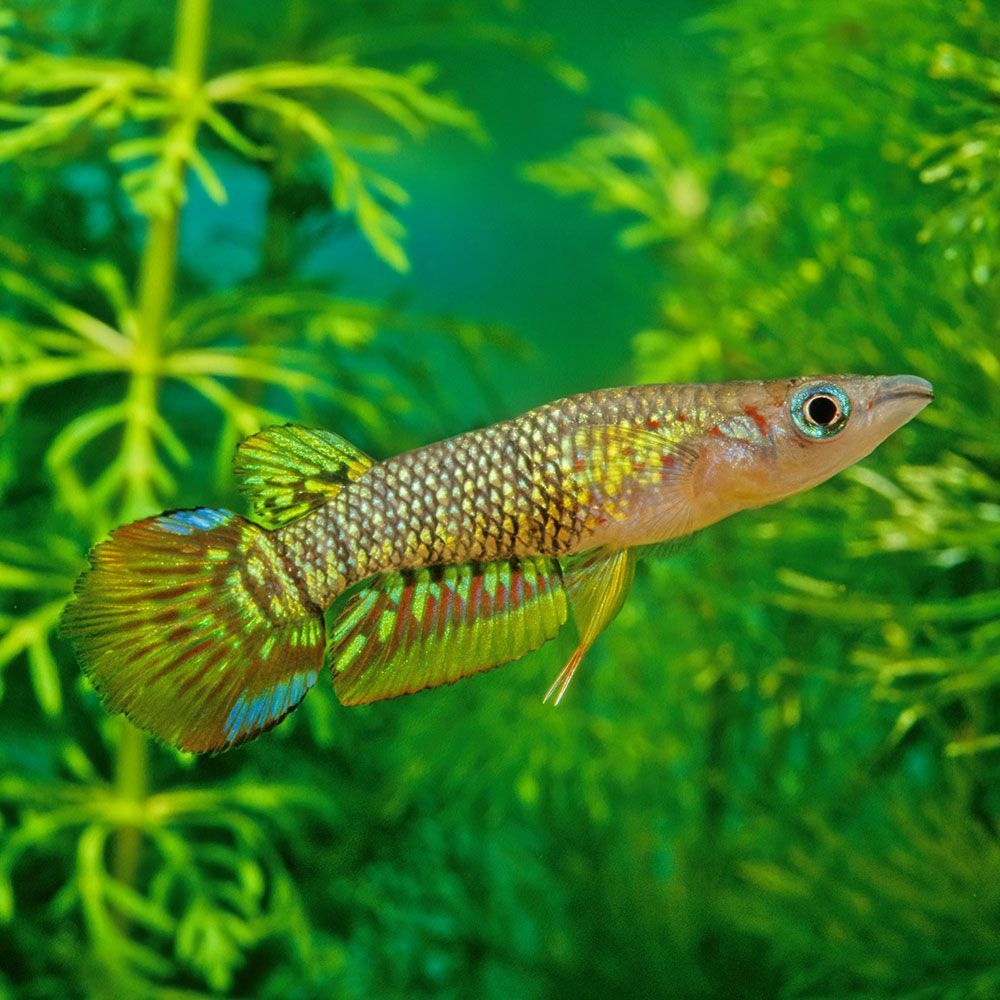
- Other Common Names: Striped panchax, Malabar killie, piki, Malabar killi, golden panchax killifish, gold killifish, yellow killifish,
- Average Size: Up to 7.6-10 cm (3-4 in)
- Average Lifespan: Up to 3-4 years, max 6 years
- Tank Level: Top-dwellers
- Temperament: Peaceful, active, aggressive, and territorial with other males
- Diet: Carnivorous, insectivorous
- Tank Mates: Own small group, other peaceful community fish of similar size
- Minimum Tank Size: 20 gallons for 4
The golden wonder killifish has a slim, elongated body with an arched back. Its dorsal fin is set further back. With rounded scales and a flat head with a pointed mouth (no barbels), this fish is golden colored and sometimes coppery with a sparkling sheen.
The fins often match the body’s color or are slightly paler, with black-edged tail and anal fins of varying intensity.
There are varieties, including red-tailed and red-tailed with white outer lobes, along with the yellow variant called Gold.
Males are more colorful, with longer fins and slimmer bodies, and can be somewhat territorial.
Females have paler colors, shorter, rounder bodies, and are generally less territorial. Further, they, along with juveniles, display 4-6 broad vertical bars near their rear sides, which extend to the base of the tail fin.
The golden wonder killifish has a special parietal eye, which is a third eye at the top of the head that helps it spot insects and predators on the water’s surface.
3. Bluefin Notho (Nothobranchius rachovii)
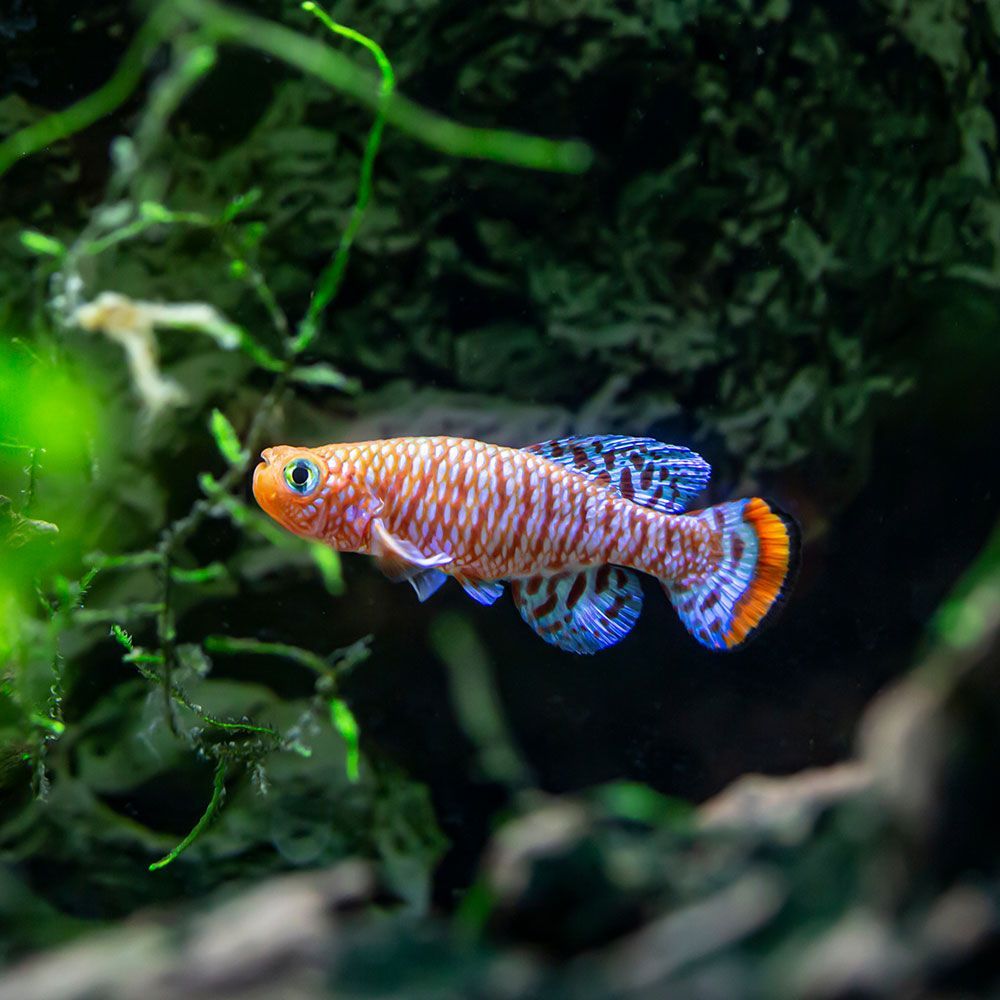
- Other Common Names: Rachows killi, rainbow killifish, rachow’s notho, blueband killifish, African blue fin annual
- Average Size: Up to 6 cm (2.4 in)
- Average Lifespan: Up to 1-1.5 year
- Tank Level: Middle or top dwellers
- Temperament: Peaceful, active, fin-nipping, aggression among males
- Diet: Omnivorous
- Tank Mates: Harem of one male and multiple females, other peaceful species
- Minimum Tank Size: 15 gallons for 3.
The bluefin notho has a slender and streamlined body with prominent dark yellow eyes and scales shimmering with iridescent blues.
Males show shades of orange and red, with intricate blue patterns on their tails and fins. Their dorsal, anal, and pelvic fins are predominantly blue with red markings, and the caudal fin has a thick black-edged orange band.
Selective breeding has led to various color variations.
Females are paler with yellow bodies, with fins edged in subtle blue tints.
The killifish lives in small water bodies that dry up during the African dry season. The eggs remain dormant for months. Adult fish lay eggs before they perish, and eggs hatch rapidly when the rainy season returns. It appears as if they have fallen with the rain, so they are often called “Rain fish” by locals.
4. Banded Killifish (Fundulus diaphanus)

- Average Size: Max up to 13 cm (5.1 in), usually 6.3 cm (2.5 in)
- Average Lifespan: Up to 3 years with best care, usually 2 years.
- Tank Level: Top dwellers
- Temperament: Peaceful, active, shoaling, aggressive towards other male conspecifics
- Diet: Carnivorous
- Tank Mates: Own school, other peaceful fish of similar size
- Minimum Tank Size: 55 gallons for 6
The banded killifish has an elongated bluish-gray or olive-colored body with 12–20 greenish-brown vertical bands along the sides. The fish has rayed dorsal and anal fins and slender bodies.
Females have thin, distinct black bands on their bodies. Males have silvery, more than 9 less distinct bands packed closely together in front of the dorsal fin.
Breeding males exhibit bright bluish-green bars with a yellow throat, pectoral and pelvic fins, blue markings on the anal fin, and brilliant blue iridescence on the lower body.
5. Least Killifish (Heterandria formosa)
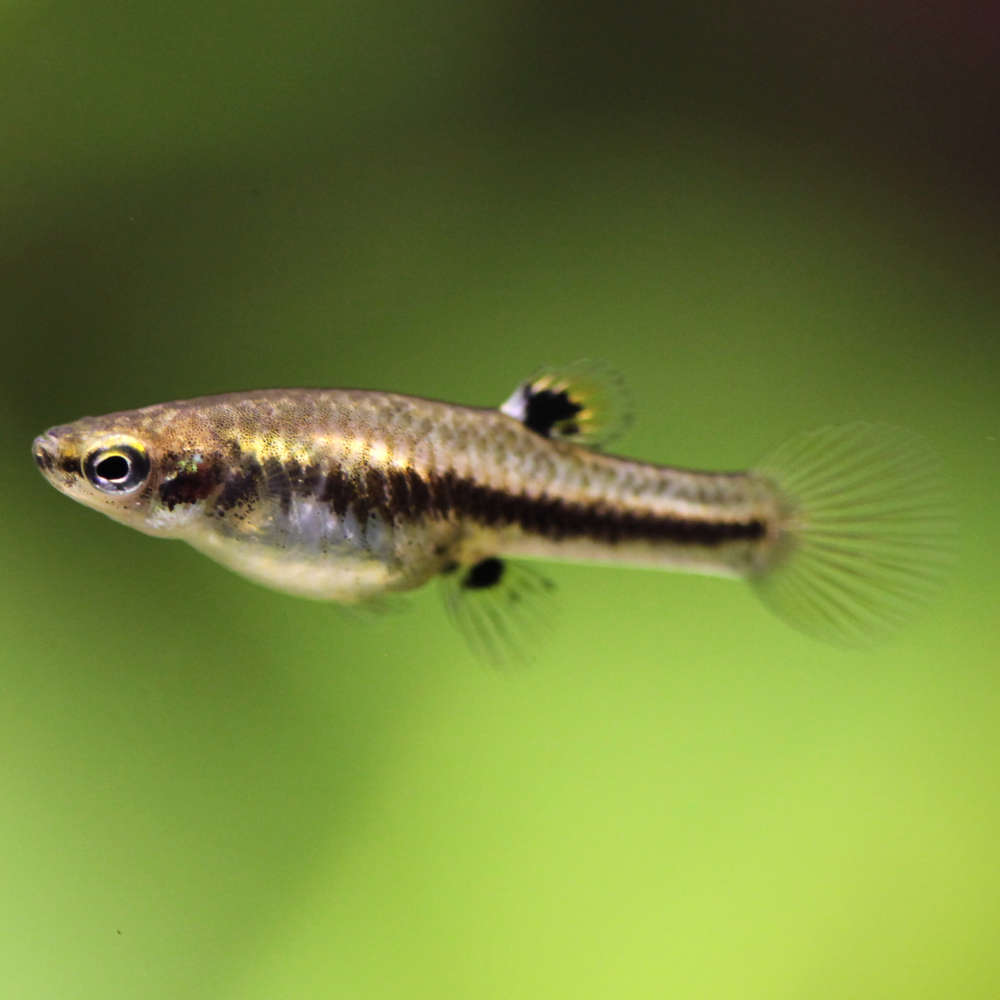
- Other Common Names: Mosquito fish, midget livebearer, dwarf topminnow
- Average Size: Up to 2 cm (0.8 in), male; up to 3 cm (1.2-1.5 in), female
- Average Lifespan: 3-5 years
- Tank Level: Top and middle dwellers
- Temperament: Highly active and peaceful
- Diet: Omnivorous
- Tank Mates: Own school, small non-predatory fish and invertebrates
- Minimum Tank Size: 20 gallons for a school
The least killifish is olive green colored with a white stomach, a dark brown body line, dark dorsal fin spot, and 6-8 vertical brown stripes.
Its body is compressed with a short snout, large eyes, and a protractile mouth. The dorsal fin is taller than long, and the ventrals are short and broad. Some specimens have a small orange spot on the dorsal fin.
Males have a gonopodium which is a modified anal fin used to transfer sperm into the female during mating. They also have a yellowish-tinted anal fin.
Females have jet-black spots at the base of the caudal, dorsal, and anal fins.
The least killifish is incredibly small and among the tiniest vertebrates in the United States. In fact, the male of this fish species might even be the smallest vertebrate globally.
6. Gardneri Killifish (Fundulopanchax gardneri)
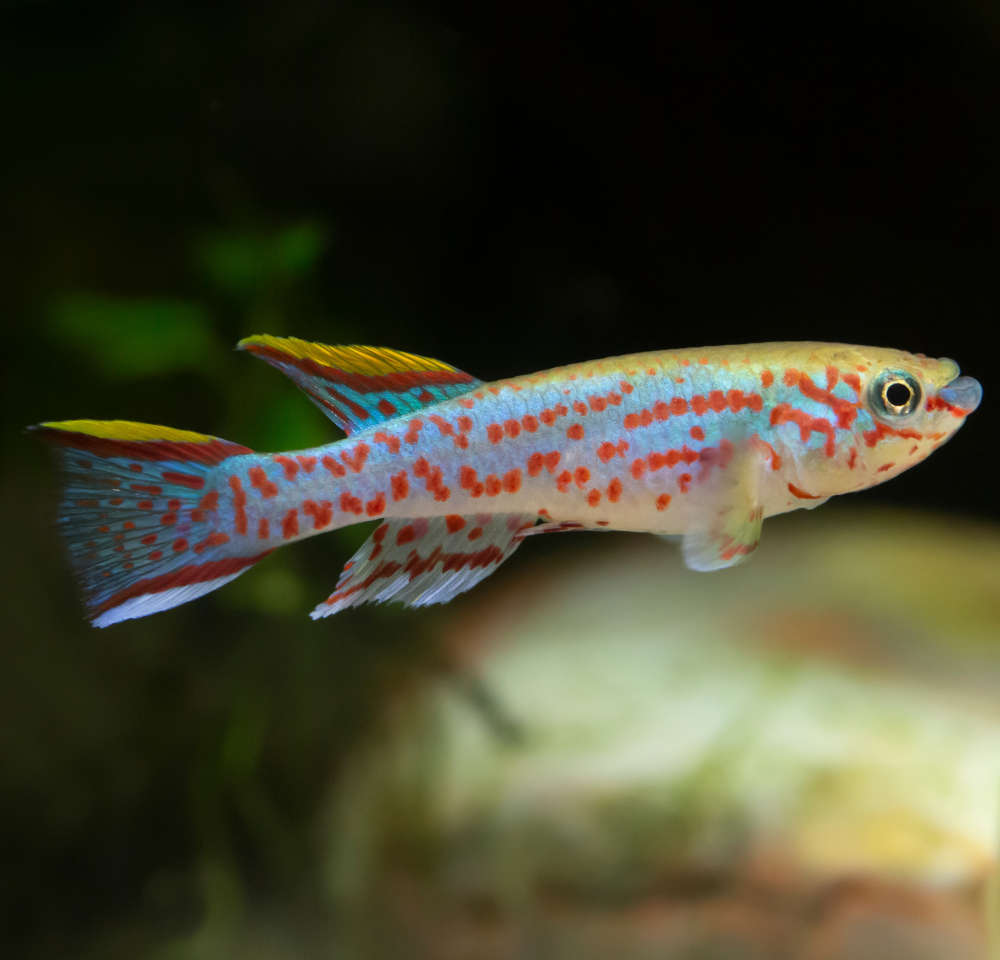
- Other Common Names: Nigerian kili, Gardner’s kili, blue lyretail, steel blue killifish
- Average Size: Up to 6.35 cm (2.5 in)
- Average Lifespan: Up to 2 years
- Tank Level: Top to middle
- Temperament: Peaceful micro predator, aggression or fin-nipping when hungry
- Diet: Carnivorous
- Tank Mates: Peaceful fish of similar size that aren’t colorful.
- Minimum Tank Size: 15 gallons for a harem of 3
The male gardneri killifish sports a blue-green body with purple accents running along its length. Its fins have yellow tips, creating a beautiful contrast.
Most males develop bright yellow or red edges on their caudal fins as they mature, forming an attractive lyretail. Their iridescent blue flanks feature deep red spots extending up to dorsal and anal fins.
The dorsal fins are positioned towards the back half of their bodies. However, males have more pronounced dorsal and anal fins.
Female fish are less colorful, slightly smaller, and have a red-spotted olive-to-tan body with a silver to light brown abdomen. Their fins are transparent, with very faint brown spots.
7. Striped Killifish (Fundulus majalis)
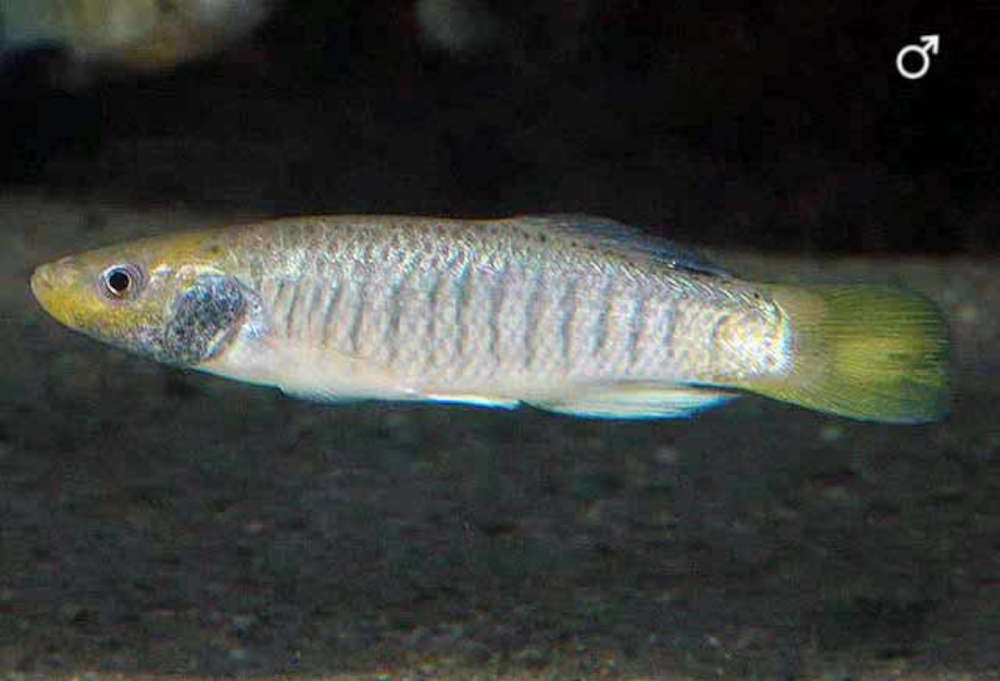
- Other Common Names: Striped kilifish, striped mummichog
- Average Size: Up to 5-10 cm (2-4 in) on average, occasionally 18 cm (7 in)
- Average Lifespan: Up to 1-5 years
- Tank Level: Middle to top
- Temperament: Fairly peaceful, schooling
- Diet: Omnivorous
- Tank Mates: Own school, peaceful fish of similar size
- Minimum Tank Size: 10 gallons (38 liters)
The fish has a slender, compressed body with long, pointed snouts. It has a silvery-olive coloration with lighter bellies.
Males feature 15 to 20 black vertical bars on each side, while females have two to three black, irregular, horizontal stripes on each side, along with a few vertical black stripes near their tail fins.
Juvenile females initially have vertical stripes, and some vertical stripes may persist on adult females near the tail. Females grow slightly larger than males, making them the largest killifish in the Chesapeake Bay.
Striped killifish have amazing tidepool survival skills. They sense when tide pools are drying up and swim out in time. If they get trapped, they’ll actually leave the water, flop across the land, and find their way back to the ocean. They move purposefully and in groups, almost like they have a built-in GPS for finding their way home.
8. Blue Gularis Killifish (Fundulopanchax sjostedti)
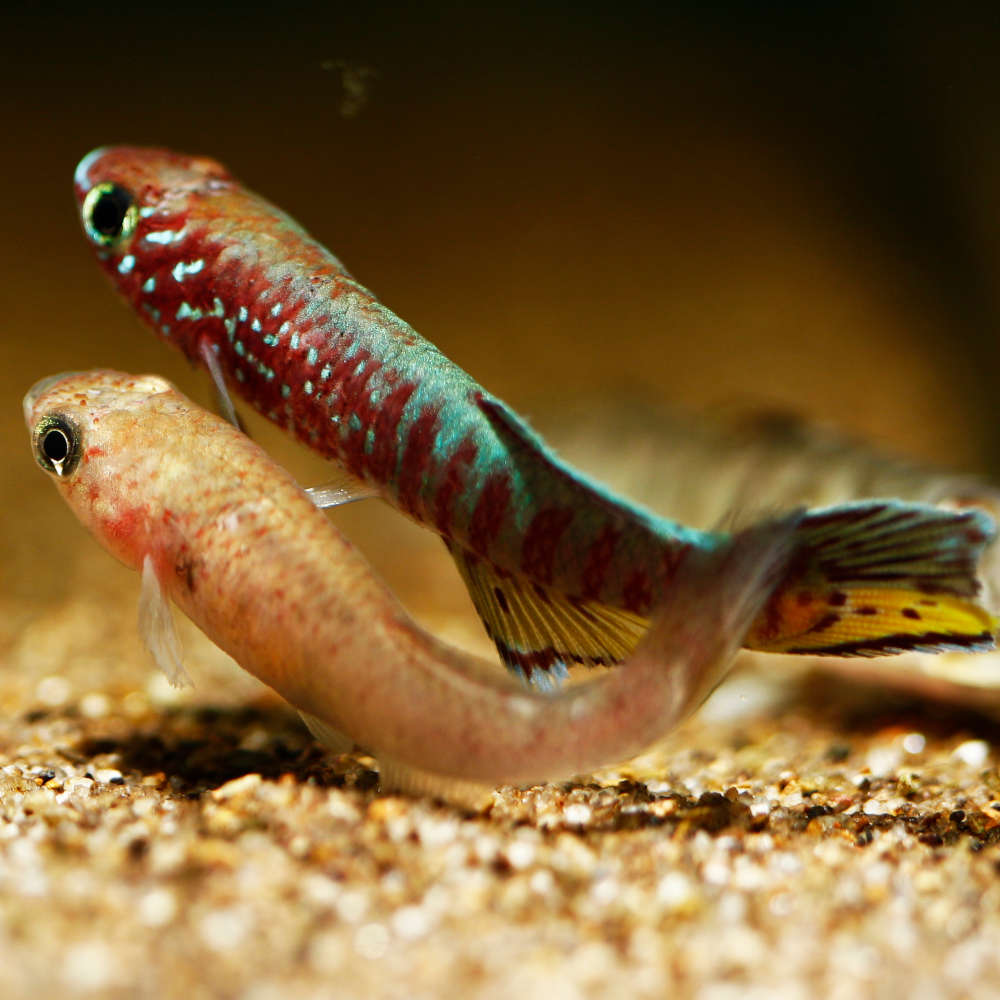
- Other Common Names: Golden pheasant gularis, red aphyosemion
- Average Size: Upto 13 cms (5.1 in)
- Average Lifespan: 3-5 years
- Tank Level: Middle or bottom dwellers
- Temperament: Peaceful, predatory, occasionally aggressive and fin-nipping
- Diet: Carnivorous
- Tank Mates: Harem of one male and two females, peaceful to semi-aggressive fish that are of similar or larger size
- Minimum Tank Size: 30 gallons for one male and two females
The blue gularis killifish is a colorful species. The male blue gularis has blue backs, orange flanks with dark reddish-brown stripes, and a striking three-pronged red and blue tail, which has black striations and dots.
It also sports white spots on purplish sides and red-marked heads. The pectoral fins have brown patches outlined in white, with white spots on the inside. The dorsal fin is yellowish-blue with a pattern similar to the caudal fin.
The female is smaller, with less vibrant colors, often gray to brown, with faint black spots, stripes, and reddish patches on its fins. It may have light red bars behind the eyes.
There are various color variations of this killifish, including the Dwarf red gularis.
9. Lampeye Killifish (Poropanchax normani)
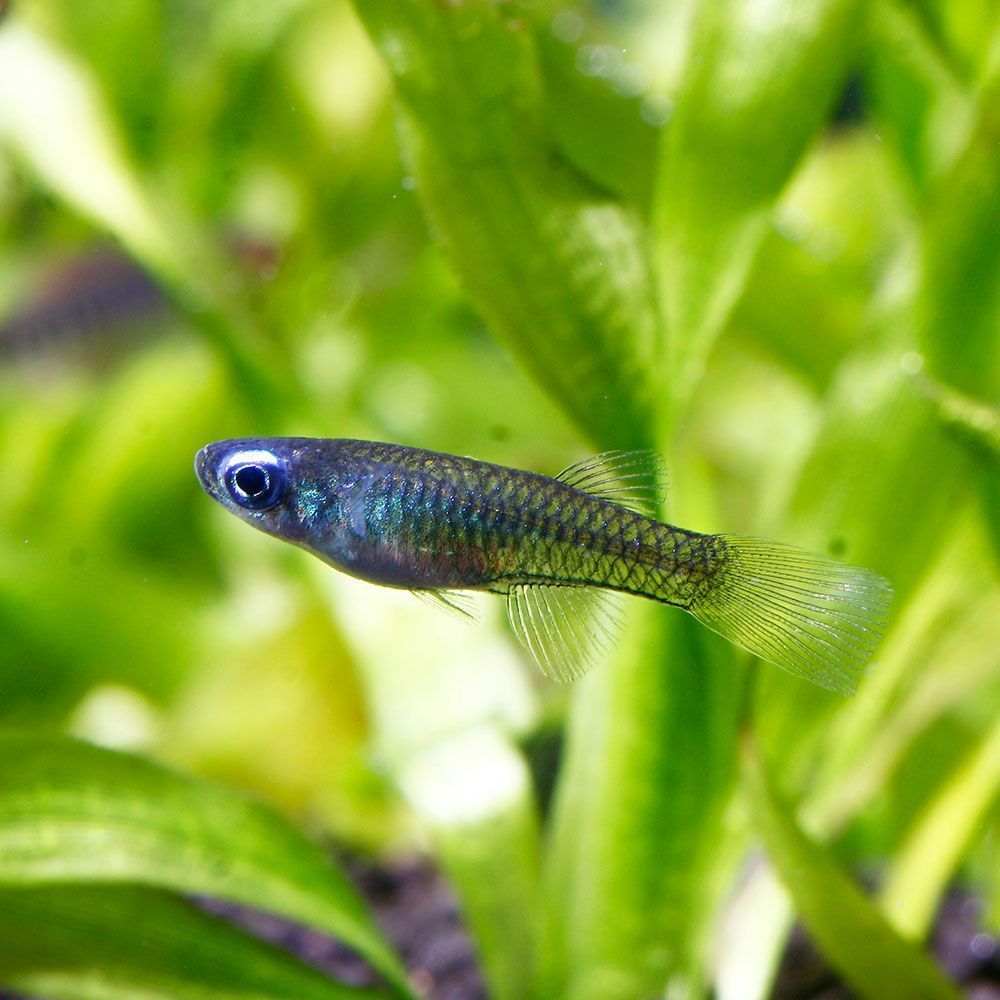
- Other Common Names: Norman’s lampeye, blue eye
- Average Size: Up to 4 cm (1.6 in) female, 4.5 cm (1.8 in) male. Max: up to 7.5 cm (3 in)
- Average Lifespan: Up to 2-5 years
- Tank Level: Top dwellers
- Temperament: Generally peaceful, aggression among males during spawning
- Diet: Primarily carnivorous
- Tank Mates: Own school, peaceful fish of similar size and larger invertebrates
- Minimum Tank Size: 30 gallons for 6
The lampeye killifish has a slender, round-scaled body with a dorsal fin towards the rear. It has a flat head with no barbels and a mouth at the tip. Its body is creamy with a pearl-like greenish-yellowish-blue tint.
Females are duller and larger, with shorter, rounded fins. Males are more colorful, with longer, pointed fins.
The Norman’s lampeye gets its name from the vibrant markings that adorn its eyes, making it a visually striking fish.
10. Bluefin Killifish (Lucania goodei)
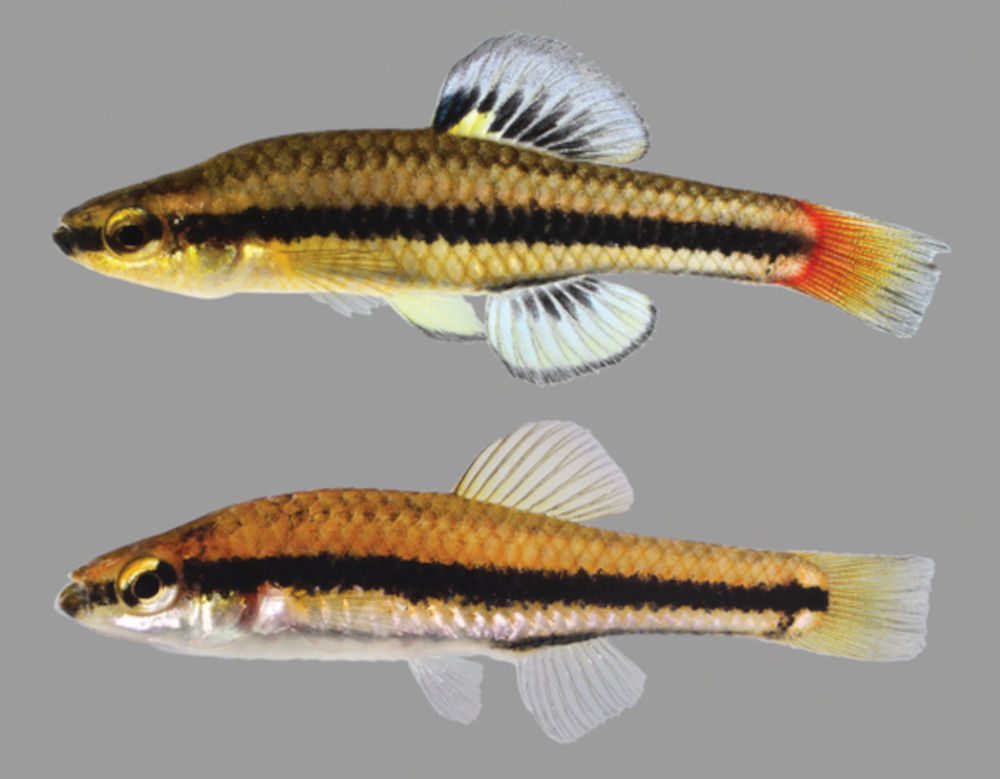
- Average Size: Usually 2.9 cm (1.1 in), Occasionally upto 6 cm (2.4 in)
- Average Lifespan: Upto 2 years
- Tank Level: Middle and top dwellers
- Temperament: Peaceful and active
- Diet: Carnivorous
- Tank Mates: Own school, other peaceful and small fish
- Minimum Tank Size: 20 gallons for a school
The body of bluefin killifish is elongated, slightly compressed, and features a pointed head and a gracefully curved dorsal fin. The primary body color is metallic silver or grey, with iridescent blue or green highlights, especially on the dorsal fin.
Usually, the fish has dark shading at the base of the dorsal and anal fins. But some specimens may have a touch of yellow on the dorsal fin’s top.
The lower body is typically pale yellow or cream with a dark side stripe. The caudal fin is transparent but may show a subtle reddish tint at the base.
Further, the fish has an upturned mouth, allowing it to breathe air from the water’s surface in challenging environments.
Males are vibrant, slender, and have elongated pointed fins. Females are less colorful, with shorter fins and a rounder body shape, often larger than males. During breeding, females may develop a subtle yellow or gold tint on fins and belly.
The species Lucania goodei received its name in honor of the American ichthyologist George Brown Goode, who collected the type specimen.
11. Gulf Killifish (Fundulus grandis)
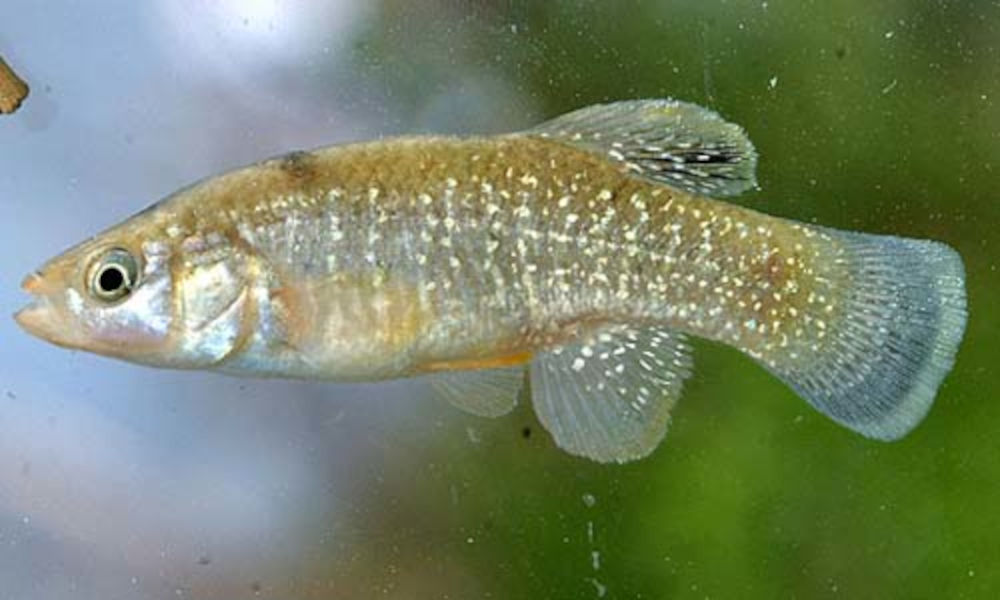
- Average Size: Usually 10 cm (4 inches). Max up to 18 cm (7 in)
- Average Lifespan: 1-2.25 year
- Tank Level: Bottom-dweller
- Temperament: Peaceful; male fish can get aggressive towards each other
- Diet: carnivorous
- Tank Mates: Peaceful species of similar size
- Minimum Tank Size: 10 gallons for three of these
Gulf killifish is said to be one of the largest killifish species. It has a slender, streamlined, elongated body that tapers toward the tail.
It has a blunt head and short snout, a mouth located very close to the front of its head, near the tip of its snout, with a slightly protruding lower jaw.
The dorsal fin generally starts before the anal fin, and its rounded anal fin has a base over half the length of its longest rays. Gill slits control water flow, extending dorsal to the uppermost pectoral-fin ray. It has a dull greenish top and lemon-yellow below.
It also has predorsal stripes, spots, and pearly side spots. The anal and caudal regions may be yellow or darker with white splotches. Overall, it has a pale belly, a darker back with pale spots, and irregular and faint bars.
Males display vivid colors, including silver flecks, stripes, and blue dorsal fins during breeding. Females are olive-colored when larger.
Gulf killifish helped scientists study the big oil spill in 2010 in the Gulf of Mexico. The oil damaged them when they swam through it, and it also affected their embryos.
12. Pike Killifish (Belonesox belizanus)

- Other Common Names: Topminnow, Pike livebearer
- Average Size: 9.7 cm (3.8 in) on average, grows up to 20 cm (7.9 in) rarely
- Average Lifespan: Up to 6 years
- Tank Level: Middle and top dwellers
- Temperament: Extremely aggressive and predatory. Gets more aggressive with age
- Diet: Carnivorous
- Tank Mates: Own harem, large aggressive or semi-aggressive species.
- Minimum Tank Size: 55 gallons for 3
The pike killifish has an elongated appearance with a flat back profile. Its lower jaw is longer than the upper jaw and upturned. It has large eyes, and a dorsal fin set far back on its body.
It is light olive/brown with a green shine, colorless fins, and small black spots on its sides. The belly is a lighter yellowish-white, and there’s a dark spot at the base of the caudal fin.
Females are livebearers with distinct elongated snouts, and males have a noticeable gonopodium for internal fertilization.
This fish is easily distinguished from other killifishes due to its appearance. The young pike killifish has a dark stripe to blend in when it floats near the surface.
With a super flexible upper jaw, the pike killifish boasts a remarkable talent for snatching up surprisingly large prey for its relatively small size.
13. Mangrove Killifish (Kryptolebias marmoratus)

- Other Common Names: Matanzas rivulus, Mangrove rivulus
- Average Size: Commonly 1-3.8 cm (0.4-1.5 in), Max up to 7.5 cm (3 in)
- Average Lifespan: 5-8 years
- Tank Level: Middle to upper level
- Temperament: Territorial and aggressive
- Diet: Carnivorous
- Tank Mates: Small fish like livebearers, tetras, rasboras and corydoras
- Minimum Tank Size: 10 gallons for 1 male and 3 females
These fish have slender, flattened bodies and rounded caudal fins and are usually dark brown to green. They have a dark spot encircled by a yellow ring near the upper caudal fin base.
They may also display mottled patterns with small black dots and hints of orange on their body and fins. Interestingly, females of this species do not appear to exist, with individuals being either male or hermaphroditic.
Mangrove killifish thrives in tropical mangroves and can survive up to 66 days on land without eating, continuing to function metabolically.
14. Rainwater Killifish (Lucania parva)

- Average Size: Commonly 3.7 cm (1.5 in), max up to 6.2 cm (2.4 in)
- Average Lifespan: 1-2 years
- Tank Level: Top dwellers
- Temperament: Peaceful schooling species, aggression among males
- Diet: Omnivorous
- Tank Mates: Small, peaceful, and semi-aggressive fish like tetras, rasboras, livebearers, etc.
- Minimum Tank Size: 20 gallons for a school
The rainwater killifish has a silvery to light green body featuring a narrow dark stripe down its back. Its scales create a cross-hatched pattern outlined in dark lines, especially noticeable in the male fish. The head has speckles, and the belly is silver, while its fins generally lack color.
Breeding males sport a black blotch on the dorsal fin and red to orange caudal, anal, and pelvic fins with black bands. They typically have 10 or more dorsal fin rays, a small, slanted mouth, and a deep and somewhat compressed body.
Males develop prickly contact organs on their heads and body. Females have a membranous sheath around the genital opening.
The rainwater killifish, scientifically named Lucania parva, got its genus name, Lucania, from a Native American word chosen for its intriguing sound but whose meaning is not known. The species name, ‘parva,’ is Latin for “small,” perfectly describing this tiny fish.
15. Black Pearl Killifish (Austrolebias nigripinnis)
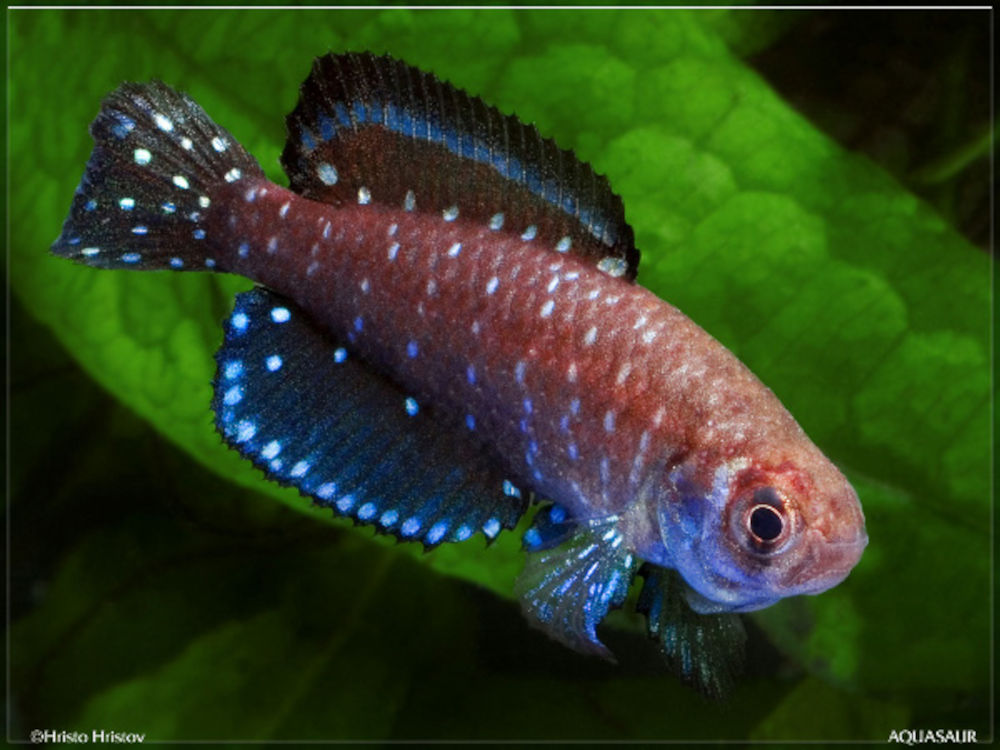
- Other Common Names: Dwarf Argentine pearlfish, blackfin pearlfish, blackfin pearl killifish
- Average Size: Usually 4.5 cm (1.78in), max up to 7 cm (2.8 in)
- Average Lifespan: 1-5 year
- Tank Level: Middle to bottom dwellers
- Temperament: Aggressive to its own kind and others
- Diet: Carnivorous
- Tank Mates: Other peaceful fish
- Minimum Tank Size: 15 gallons for 1 male and 2-3 females
The black pearl killifish species is known for its striking blue-black color with metallic-green edges on the fins. It also has pearly white to greenish patches on its body and fins.
Both males and females have a dark brownish stripe. But males typically have a dark blue and blue-green body with pearly white spots. Females have an ochre or yellow-green body with brownish stripes resembling marble grain.
The anal, dorsal, and caudal fins in males have dark brown edges.
The courtship behavior of the fish is unique. The male dances and darts back and forth, encircling the female to flaunt his most vibrant colors. Then, he lowers his mouth and starts digging in the substrate for an ideal spot to deposit the future eggs.
A word from FishInAquarium
The visually appealing killifish species are great fish for beginner aquarists. Most species of these fish are generally peaceful and can coexist harmoniously with other community fish. They might be pricey, but absolutely seem worth it when you bring them home!
With over a thousand types to choose from, you can find a killifish that fits your aquarium perfectly.
Now, if you enjoyed learning about these fascinating fish, please consider sharing this article with fellow aquarists. And if you have any queries, don’t worry, simply shoot an email, and we will get back to you.

